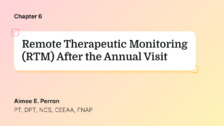Unveiling the Potential of the Physical Therapy
Annual Visit (Recorded Webinar)
Presented by Aimee E. Perron

12-Month Subscription
Unlimited access to:
- Thousands of CE Courses
- Patient Education
- Home Exercise Program
- And more
This course is a recording of a previously hosted live webinar event. Polling and question submission features are not available for this recording. Format and structure may differ from those of standard Medbridge courses.
Routine physical therapy check-ups are emerging as essential preventive healthcare tools, especially for aging adults looking to maintain mobility and independence. The American Physical Therapy Association (APTA) promotes an annual physical therapy visit, recommending it for older adults similarly to annual medical check-ups. During these visits, a PT assesses movement and function to establish baseline abilities, identify areas of risk, address rehabilitation needs, and recommend any necessary referrals or health promotion plans.
These assessments empower patients to address limitations early, supporting active, independent aging while potentially reducing healthcare costs. However, a knowledge gap remains, as many providers are not fully aware of the benefits of these assessments. Bridging this gap can position physical therapy as a core component of preventive care, allowing PTs to optimize movement; promote health, wellness, and fitness; and slow the progression of impairments, activity limitations, and participation restrictions.
Learning Objectives
- Determine the rationale for incorporating annual physical therapy visits as a preventive strategy for maintaining optimal physical function in aging
- Implement comprehensive physical therapy annual visits to proactively manage health, manage wellness, and prevent age-related decline
- Use patient/client self-assessments to identify opportunities for improving health and mitigating risks
- Select and organize assessment tools effectively for use in physical therapy annual visits
- Construct personalized health promotion plans and strategies for remote monitoring to support active aging and independence
Meet your instructor

Aimee E. Perron
Aimee E. Perron is currently an assistant professor and associate director of clinical education at Northeastern University in Boston, Massachusetts. She earned her MS in physical therapy from Boston University and her DPT from Massachusetts General Hospital Institute of Health Professions. She has more than 27 years of…
Chapters & learning objectives

1. What Is a Physical Therapy Annual Visit, and Why Is It Important?
Evidence shows that annual wellness visits improve health outcomes, especially for aging adults, by supporting mobility, independence, and quality of life. This chapter introduces the physical therapy annual visit, explaining what it entails and why it is crucial in proactive health management.

2. Strengthening the Annual Visits With Health Risk Assessments
The first step in delivering preventive services within physical therapy is incorporating a health risk assessment (HRA) into your patient intake form. This addition can elevate the physical therapy annual visit by providing a streamlined way to collect self-reported data on lifestyle choices and social factors impacting patient health. In this session, we’ll discuss how HRAs help you identify risks related to physical function, mobility, and quality of life, supporting proactive, personalized care for each patient.

3. The Multisystem and Movement Assessment
This chapter outlines the key components of a physical therapy annual visit evaluation, emphasizing essential assessments to include. A recorded demonstration will also illustrate practical application for effective implementation.

4. Bringing It All Together: Clinical Application
This chapter will cover essential components, using case-based examples to illustrate topics such as referrals, billing, documentation, and setting measurable, person-centered goals. Additionally, the presenter will discuss methods for determining meaningful outcomes for short-term services and will highlight the importance of patient education and key factors to consider before designing a personalized health promotion plan.

5. Beyond the Initial Visit
This chapter guides PTs in developing personalized health promotion plans focused on prevention and lifestyle medicine. It covers when to recommend skilled services or individualized programs, with an emphasis on behavior change strategies for sustainability. Key topics include risk stratification, social determinants of health, and preventive care to support overall health and chronic disease prevention, expanding PT’s role beyond traditional therapy.

6. Remote Therapeutic Monitoring (RTM) After the Annual Visit
This chapter explores the use of RTM after a physical therapy annual visit, focusing on its benefits, including enhanced patient progress tracking and adherence to health promotion plans. Case examples using RTM codes will illustrate practical applications, covering patient engagement and reimbursement considerations.

7. Question and Answer Session
This chapter is a viewer-submitted question and answer session facilitated by Aimee Perron.